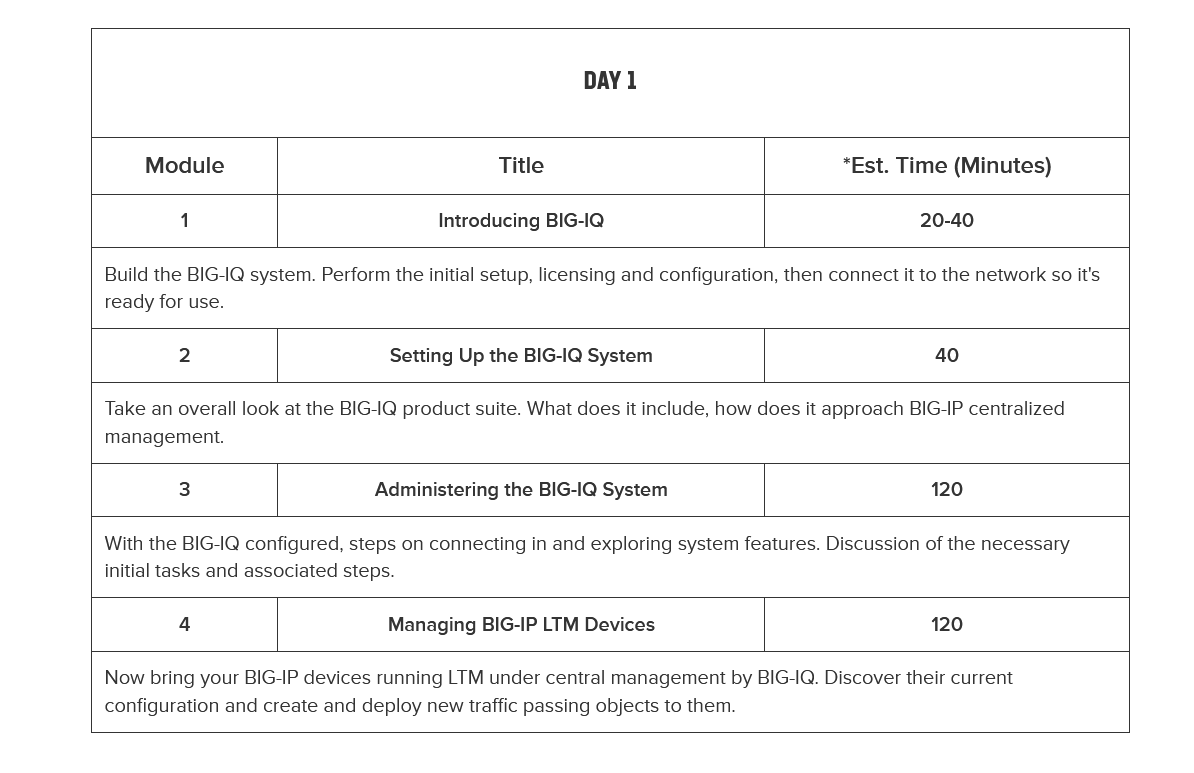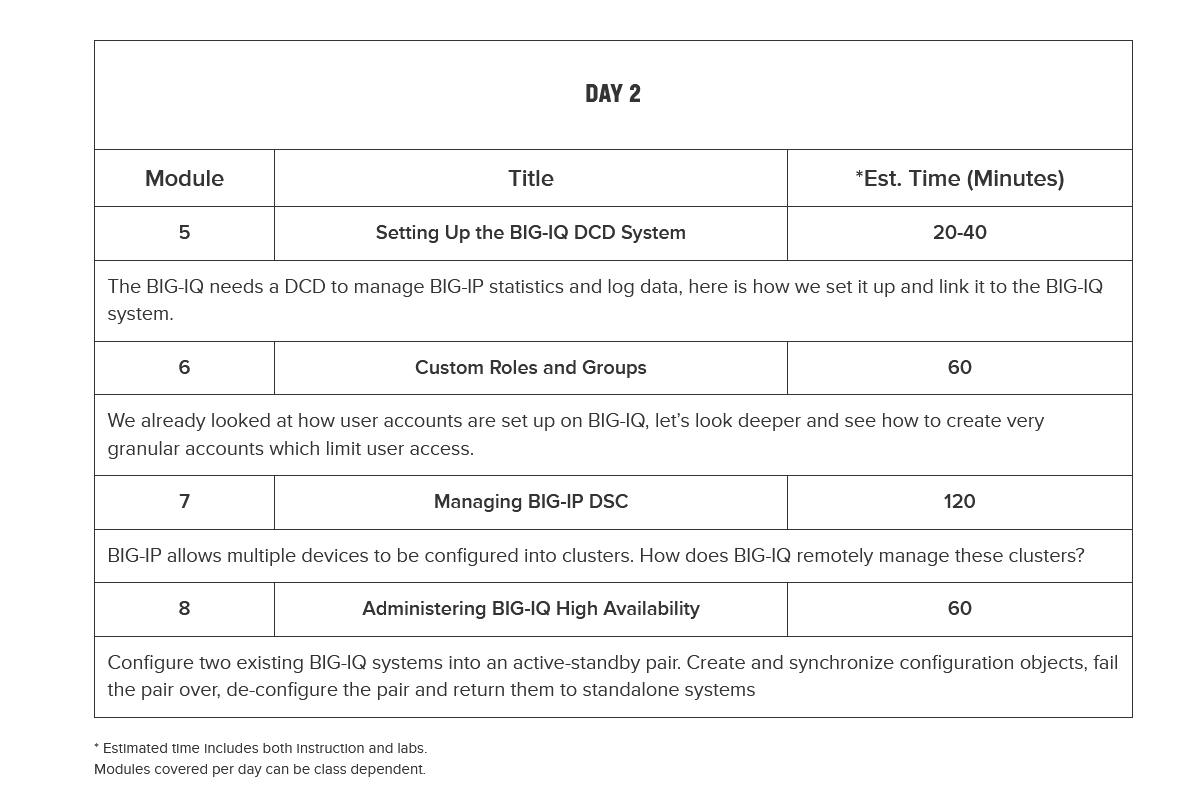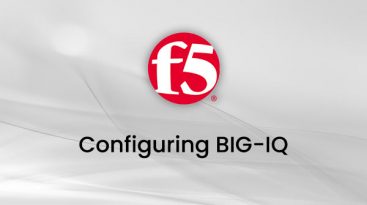Overview
We first look at building and configuring the BIG-IQ system. Once this initial classroom environment is built, we detail the steps to get going administering BIG-IQ, then use it to manage BIG-IP devices. After this we examine other system configurations; setting up a BIG-IQ DCD logging device, building a BIG-IQ High Availability pair, and managing BIG-IP devices in a cluster.
Duration 2 days.
You can find current trainings on training calendar page.
Training Prerequisites
BIG-IQ manages BIG-IP devices and its associated products so you need to be familiar with BIG-IP as well as having knowledge and experience of general network technology. For BIG-IP, students should have already completed a BIG-IP based training course such as the Administering BIG-IP instructor-led course or further courses. Free web-based training courses are available on the LearnF5 training hub (https://www.f5.com/services/training) that are helpful for any student with limited BIG-IP administration and configuration experience.
General technology experience should cover:
- OSI model encapsulation
- Routing and switching
- TCP/IP concepts
- IP addressing and subnetting
- Network firewalls
- LAN vs. WAN
- HTTP Protocol
- Security and Authentication
Training Contents
The content of this training is as follows. We recommend that you review before training.
- BIG-IQ Centralized Management
- BIG-IQ Approach
- BIG-IQ Core Functionality
- REST API
- BIG-IQ Data Collection Device (DCD)
- BIG-IP Cloud Edition (CE)
- Setting Up the BIG-IQ System
- Controlling Access to the BIG-IQ
- Creating, Authenticating, Configuring Users and their Roles
- System Backups
- Configuring DNS, NTP, and SMTP
- Monitoring the BIG-IQ, DCD, and BIG-IP events and alerts
- Monitoring BIG-IQ with iHealth
- Post Installation Issues; Licensing, Changing Management IP, Master Key, Restoring Backups
- Managing BIG-IP LTM Devices
- BIG-IP LTM Device Discovery
- BIG-IP Device Backup
- Deploying to BIG-IP Devices, Various Methods and Logs
- BIG-IQ Configuration Snapshots
- Managing BIG-IP Certificates
- Managing BIG-IP Licenses
- Monitoring BIG-IP Devices with iHealth
- Management of QKView Reports from Managed BIG-IP DevicesManaging BIG-IP LTM Devices
- Setting Up the BIG-IQ Data Collection Device
- Custom Role Types and Groups
- Setting up User Accounts with custom roles and privileges
- Managing BIG-IP DSC
- Discovery and management of BIG-IP Device Clusters (DSC) with BIG-IQ
- Administering BIG-IQ High Availability
- Configuration and management of BIG-IQ systems in a High Availability pair
Training Objectives
- Build the BIG-IQ system. Perform the initial setup, licensing and configuration, then connect it to the network so it's ready for use
- Take an overall look at the BIG-IQ product suite. What does it include, how does it approach BIG-IP centralized management
- With the BIG-IQ configured, connect and explore system features including the necessary initial tasks and associated steps
- Bring your BIG-IP devices running LTM under central management by BIG-IQ. Discover their current configuration and create and deploy new traffic passing objects to them
- The BIG-IQ needs a DCD to manage BIG-IP statistics and log data, see how to set it up and link it to the BIG-IQ system
- Take a deeper look into user accounts on BIG-IQ and see how to create very granular accounts which limit user access
- BIG-IP allows multiple devices to be configured into clusters. Learn how BIG-IQ remotely manages these clusters
- Configure two existing BIG-IQ systems into an active-standby pair. Create and synchronize configuration objects, fail the pair over, de-configure the pair and return them to standalone systems.
Who should attend?
The course is for system and network administrators responsible for the installation, setup, configuration, and administration of the BIG-IQ system. Or, it can be undertaken by operators who require some knowledge of how the systems are setup, but usually concentrate on performing particular operational tasks whether on BIG-IQ or via BIG-IQ on the managed BIG-IP devices.
- Overview
- Prerequisites
- Contents
- Objectives
- Audience
Overview
We first look at building and configuring the BIG-IQ system. Once this initial classroom environment is built, we detail the steps to get going administering BIG-IQ, then use it to manage BIG-IP devices. After this we examine other system configurations; setting up a BIG-IQ DCD logging device, building a BIG-IQ High Availability pair, and managing BIG-IP devices in a cluster.
Duration 2 days.
You can find current trainings on training calendar page.
Training Prerequisites
BIG-IQ manages BIG-IP devices and its associated products so you need to be familiar with BIG-IP as well as having knowledge and experience of general network technology. For BIG-IP, students should have already completed a BIG-IP based training course such as the Administering BIG-IP instructor-led course or further courses. Free web-based training courses are available on the LearnF5 training hub (https://www.f5.com/services/training) that are helpful for any student with limited BIG-IP administration and configuration experience.
General technology experience should cover:
- OSI model encapsulation
- Routing and switching
- TCP/IP concepts
- IP addressing and subnetting
- Network firewalls
- LAN vs. WAN
- HTTP Protocol
- Security and Authentication
Training Contents
The content of this training is as follows. We recommend that you review before training.
- BIG-IQ Centralized Management
- BIG-IQ Approach
- BIG-IQ Core Functionality
- REST API
- BIG-IQ Data Collection Device (DCD)
- BIG-IP Cloud Edition (CE)
- Setting Up the BIG-IQ System
- Controlling Access to the BIG-IQ
- Creating, Authenticating, Configuring Users and their Roles
- System Backups
- Configuring DNS, NTP, and SMTP
- Monitoring the BIG-IQ, DCD, and BIG-IP events and alerts
- Monitoring BIG-IQ with iHealth
- Post Installation Issues; Licensing, Changing Management IP, Master Key, Restoring Backups
- Managing BIG-IP LTM Devices
- BIG-IP LTM Device Discovery
- BIG-IP Device Backup
- Deploying to BIG-IP Devices, Various Methods and Logs
- BIG-IQ Configuration Snapshots
- Managing BIG-IP Certificates
- Managing BIG-IP Licenses
- Monitoring BIG-IP Devices with iHealth
- Management of QKView Reports from Managed BIG-IP DevicesManaging BIG-IP LTM Devices
- Setting Up the BIG-IQ Data Collection Device
- Custom Role Types and Groups
- Setting up User Accounts with custom roles and privileges
- Managing BIG-IP DSC
- Discovery and management of BIG-IP Device Clusters (DSC) with BIG-IQ
- Administering BIG-IQ High Availability
- Configuration and management of BIG-IQ systems in a High Availability pair
Training Objectives
- Build the BIG-IQ system. Perform the initial setup, licensing and configuration, then connect it to the network so it's ready for use
- Take an overall look at the BIG-IQ product suite. What does it include, how does it approach BIG-IP centralized management
- With the BIG-IQ configured, connect and explore system features including the necessary initial tasks and associated steps
- Bring your BIG-IP devices running LTM under central management by BIG-IQ. Discover their current configuration and create and deploy new traffic passing objects to them
- The BIG-IQ needs a DCD to manage BIG-IP statistics and log data, see how to set it up and link it to the BIG-IQ system
- Take a deeper look into user accounts on BIG-IQ and see how to create very granular accounts which limit user access
- BIG-IP allows multiple devices to be configured into clusters. Learn how BIG-IQ remotely manages these clusters
- Configure two existing BIG-IQ systems into an active-standby pair. Create and synchronize configuration objects, fail the pair over, de-configure the pair and return them to standalone systems.
Who should attend?
The course is for system and network administrators responsible for the installation, setup, configuration, and administration of the BIG-IQ system. Or, it can be undertaken by operators who require some knowledge of how the systems are setup, but usually concentrate on performing particular operational tasks whether on BIG-IQ or via BIG-IQ on the managed BIG-IP devices.






